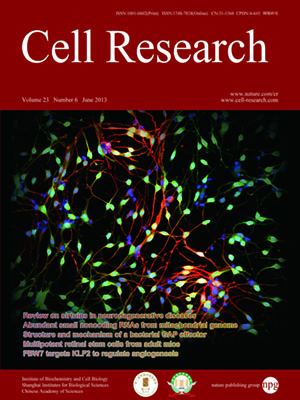
Volume 23, No 6, Jun 2013
ISSN: 1001-0602
EISSN: 1748-7838 2018
impact factor 17.848*
(Clarivate Analytics, 2019)
Volume 23 Issue 6, June 2013: 788-802
ORIGINAL ARTICLES
Multipotent stem cells isolated from the adult mouse retina are capable of producing functional photoreceptor cells
Tianqing Li1,*, Michelle Lewallen1,*, Shuyi Chen1,*, Wei Yu1, Nian Zhang1 and Ting Xie1,2
1Stowers Institute for Medical Research, 1000 East 50th Street, Kansas City, MO 64110, USA
2Department of Anatomy and Cell Biology, University of Kansas School of Medicine, 3901 Rainbow Blvd, Kansas City, KS 66160, USA
Correspondence: Ting Xie(tgx@stowers.org)
Various stem cell types have been tested for their potential application in treating photoreceptor degenerative diseases, such as retinitis pigmentosa (RP) and age-related macular degeneration (AMD). Only embryonic stem cells (ESCs) have so far been shown to generate functional photoreceptor cells restoring light response of photoreceptor-deficient mice, but there is still some concern of tumor formation. In this study, we have successfully cultured Nestin+Sox2+Pax6+ multipotent retinal stem cells (RSCs) from the adult mouse retina, which are capable of producing functional photoreceptor cells that restore the light response of photoreceptor-deficient rd1 mutant mice following transplantation. After they have been expanded for over 35 passages in the presence of FGF and EGF, the cultured RSCs still maintain stable proliferation and differentiation potential. Under proper differentiation conditions, they can differentiate into all the major retinal cell types found in the adult retina. More importantly, they can efficiently differentiate into photoreceptor cells under optimized differentiation conditions. Following transplantation into the subretinal space of slowly degenerating rd7 mutant eyes, RSC-derived photoreceptor cells integrate into the retina, morphologically resembling endogenous photoreceptors and forming synapases with resident retinal neurons. When transplanted into eyes of photoreceptor-deficient rd1 mutant mice, a RP model, RSC-derived photoreceptors can partially restore light response, indicating that those RSC-derived photoreceptors are functional. Finally, there is no evidence for tumor formation in the photoreceptor-transplanted eyes. Therefore, this study has demonstrated that RSCs isolated from the adult retina have the potential of producing functional photoreceptor cells that can potentially restore lost vision caused by loss of photoreceptor cells in RP and AMD.
10.1038/cr.2013.48
FULL TEXT | PDF
Browse 2456


